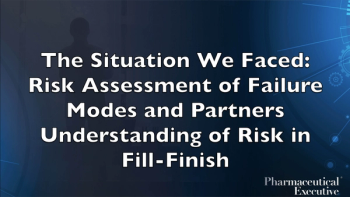
Patient Centricity by Prodrug Design
Travis Mickle, CEO of KemPharm, talks about his company’s use of prodrugs, the business opportunities prodrugs represent, and how prodrugs are helping to improve patient centricity.
The biopharmaceutical industry has brought on many aspects of patient centricity, ranging from clinical trial design to incorporating digital health in outcomes. Some companies, however, are taking patient centricity to another level by utilizing prodrug technology to design better drugs. Elegant in concept, the therapeutic rationale of a prodrug is to improve the physicochemical, biopharmaceutical, or pharmacokinetic properties of an active pharmaceutical ingredient (API). One such company, KemPharm, Inc., has built its business on the significant opportunity that prodrugs offer, both in the development of improved versions of FDA-approved drugs as well as the ability to generate prodrug versions of existing compounds that may have applications for new disease indications. Travis Mickle, CEO of KemPharm, will discuss his company’s use of prodrugs, the business opportunities prodrugs represent, and how prodrugs are helping to improve patient centricity.
Moe Alsumidaie: What are prodrugs and how are they different from traditional medications when treating attention deficit hyperactive disorder (ADHD)?Travis Mickle: Prodrugs offer an exquisite opportunity to improve the functionality of traditional drugs. We leverage our Ligand Activated Therapy (LAT) technology to identify and attach ligands to the parent drug. The ligands we use are inactive and generally recognized as safe compounds that are covalently bonded to the active pharmaceutical ingredient, resulting in a new molecular entity. Once the prodrug is administered, the patient gets the benefit of the new design of the traditional drug, such as duration of effect, potency or even abuse-resistance, while maintaining the therapeutic intent of the original drug.
MA: How does a prodrug improve traditional drug mechanisms of action?
TM: You can do many different things with a prodrug that you can't do in a formulated product. For example, if a drug is heavily abused or misdirected, a prodrug can be designed so that it only breaks down in the gastrointestinal (GI) tract following standard oral administration. Injecting or snorting the drug would produce no effect because enzymes needed to break it down and release the API are only found in the gut. Several of KemPharm’s prodrugs, including our ADHD products, KP415 and KP484, are designed like this to offer protection against drug abuse. That's where we see just one of the potential advantages of a prodrug, but there's a laundry list of other benefits.
MA: You recently announced that you expect to file a new drug application (NDA) for KP415 in Q2. Can you describe the product and potential advantages that it offers for ADHD patients?
TM: KP415 is a prodrug of methylphenidate, one of the two main classes of stimulant therapies used to treat ADHD; the other being amphetamine. With KP415, we are trying to improve both onset and total duration of methylphenidate, while also creating something that's less abusable. Those are vital needs that aren't being met with currently available methylphenidate products. If you think about it, for younger patients and parents, it’s advantageous to have a product that starts to work before the child leaves the house in the morning. Then, that same product needs to last through the end of the day, into homework time, before wearing off before bed. Timing wise, we’re talking about a drug that produces an effect within 30 minutes of dosing and lasts for approximately 13 hours. When measured against these criteria, today’s methylphenidate products have fallen short. KP415, on the other hand, demonstrated this exact profile in its pivotal efficacy study, while also showing an ability to limit abuse if injected, inhaled, or taken orally at high doses.
MA: KP484 is also targeting ADHD. What's the difference between KP484 and KP415, and how does it differ from other ADHD medications currently on the market?
TM: KP484 is designed to be more for adults who require around-the-clock coverage of their ADHD symptoms while KP415 is a broad product applicable to kids, teenagers, and adults. With KP484, there is a subset of adults who currently take two or three medications to address their symptoms, which can be debilitating as far as social interactions and job retention, to name a few. A product called Mydayis is already an approved amphetamine-based product which was developed for this purpose. KP484 would provide a methylphenidate option for this adult population.
MA: APADAZ is KemPharm’s FDA approved prodrug of hydrocodone and acetaminophen for acute pain. Recently, you announced a licensing agreement with KVK-Tech to commercialize the drug. Where do things stand and when can we expect to see APADAZ hit the market?
TM: APADAZ is going along very well. We've hit some critical early goals, including our recently announced news that the authorized generic of APADAZ currently has unrestricted formulary access for 91% of commercial lives and unlimited access for 90% of state Medicaid lives according to Managed Markets Insight & Technology (MMIT) estimates. We believe this milestone indicates that KemPharm’s strategy of offering an authorized generic of APADAZ at prices comparable to a generic may be an attractive proposition. Overall, we continue to believe that the replacement of current hydrocodone/acetaminophen products with APADAZ and its authorized generic will be a meaningful market opportunity based on this achievement and prior discussions with payors. We continue to work with our partner, KVK Tech, to advance APADAZ towards a second half 2019 launch.
MA: You’ve added KP879 to your pipeline for Stimulant Use Disorder or (SUD). What is SUD, and how does KP879 address this problem?
TM: SUD, as you said, is stimulant use disorder. This is cocaine, methamphetamine, and other stimulant drugs where an individual becomes addicted, and they're looking for a treatment option. If you become addicted to opioids, there are products that are buprenorphine-based, and there have been methadone clinics for many years. However, there's absolutely nothing to treat stimulant use disorder.
KP879 utilizes serdexmethylphenidate or SDX, KemPharm’s prodrug of d-methylphenidate or d-MPH, which is also the primary active pharmaceutical ingredient of KP415 and KP484. SDX, like methylphenidate, is a stimulant. Interestingly, among the many potential drug therapies that have been studied for the treatment of SUD, medications with central nervous system (CNS) stimulant-like properties have shown the most benefit.
Based on information gathered during the KP415 and KP484 development programs, we recognized that SDX has pharmacokinetic properties that are desirable as an agonist replacement therapy for the treatment of SUD. Specifically, we observed that SDX provided a gradual onset followed by a long duration of d-MPH exposure, while also exhibiting the potential for a reduction in abuse-related effects. As a result, KP879 represents a significant development for KemPharm as it adds a new product candidate to our pipeline that could potentially address a significant unmet medical need.
MA: KemPharm’s business strategy is to leverage this technology platform to develop prodrugs in partnership with other pharma. For example, you announced a tech collaboration with twoXAR to develop novel prodrugs. Can you talk about this agreement, and KemPharm's product development and partnering strategy?
TM: twoXAR is an exciting organization. They use artificial intelligence (AI) technology to look through databases of drugs that have either been approved, developed, or where there's a fair amount of data to identify alternative indications. With this agreement, twoXAR will locate a new molecule, which we’ll then discover a prodrug version of and, essentially, hand it back to them. They do all the development work, commercialize the product, and license or sell it. We get the downstream benefits of royalties and milestones without dilution of our resources. We think that's a great approach to our broader prodrug development and partnering strategy. We don't intend right now to commercialize our products. That may change in the future, but fundamentally we want to discover prodrugs, seek licensing partners like KVK for APADAZ and a potential partner for KP415 and KP484, and ultimately produce long-term value for the organization.
MA: What are some of the key milestones for KemPharm on the horizon?
TM: We currently have a couple of critical milestones. We’re looking for a partner for KP415 and KP484 that will help us get the products approved and ultimately commercialized as well as filing the NDA for KP415. In the second half of the year, we expect to have APADAZ launched, and that's a revenue-based deal with KVK where we get up to 50% of a profit split. These are two big milestones. We have others that we expect to materialize, as well, so 2019 is a year of value realization for KemPharm.
Moe Alsumidaie, MBA, MSF is Chief Data Scientist at Annex Clinical
Newsletter
Lead with insight with the Pharmaceutical Executive newsletter, featuring strategic analysis, leadership trends, and market intelligence for biopharma decision-makers.




